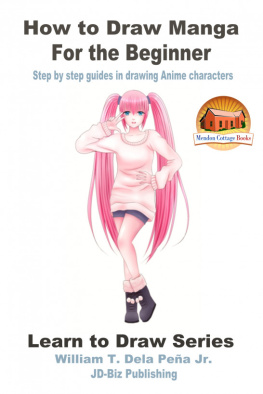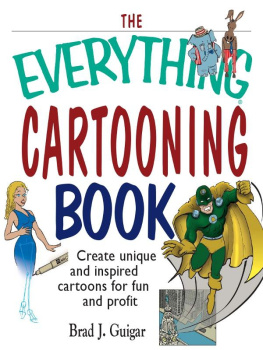
Who doesnt enjoy cartoons, whether it is the sharp, satirical wit of daily political cartoons or the warm and familiar humour of your favourite comic strip character? Or perhaps your preference is death-defying adventure in the company of a superhero or manga warrior.
Whatever your own cartoon likes and dislikes, it is extremely unlikely that you would be reading this introduction if you were not one of the many people who enjoy cartoons and have also thought at some point: I wish I could do that. You may even have already started cartooning and are now hoping to polish your skills to a more professional level.
The good news is that everyone can do that, whether their goal is simply to draw cartoons for fun, or to work one day in what is a fast growing, diverse industry. In this book, you will learn the basic drawing techniques on which all cartoonists build their pictures, regardless of whether the end result is a funny animal or a fearsome super villain. You will be introduced to different styles, ranging from manga to caricature, and you will also learn to produce jokes and stories for your newly created characters to act out.
This book features work by several cartoonists with different styles. The key to making the book work for you is to try all the techniques and ideas, step by step, in whatever style is comfortable. Some of the ideas will work better than others, depending on your likes and dislikes and where you are currently at dont worry if youve never drawn before. The more ideas you try, the more fun youll have and having fun is the best way to ensure your readers will, too.
Everything you need to know to be able to draw cartoons is contained in these pages, and if youve got something to draw with, something to draw on and your sense of humour and adventure, you already have everything you need to take advantage of it.

First published in 2008 by Collins
an imprint of HarperCollinsPublishers
7785 Fulham Palace Road
Hammersmith, London W6 8JB
The Collins website address is:
www.harpercollins.co.uk
Collins is a registered trademark of HarperCollins Publishers Limited
HarperCollins Publishers, 2008
Created by: SP Creative Design
Editor: Heather Thomas
Designer: Rolando Ugolini
Lead artists: John Byrne and Spencer Hill
Contributing artists: Evil Twin Artworks, Alex Hughes, Meg Jones, James Pearson, Leonard Noel White
All rights reserved under International and Pan-American Copyright Conventions. By payment of the required fees, you have been granted the nonexclusive, nontransferable right to access and read the text of this e-book on-screen. No part of this text may be reproduced, transmitted, downloaded, decompiled, reverse-engineered, or stored in or introduced into any information storage and retrieval system, in any form or by any means, whether electronic or mechanical, now known or hereinafter invented, without the express written permission of HarperCollins e-books.
HarperCollinsPublishers has made every reasonable effort to ensure that any picture content and written content in this ebook has been included or removed in accordance with the contractual and technological constraints in operation at the time of publication.
Source ISBN: 9780007263929
Ebook Edition NOVEMBER 2013 ISBN: 9780007556625
Version: 2013-11-04
Contents

Although the term cartoon as we know it is relatively recent, the idea of using simple pictures to make a point, a joke or tell a story is very ancient indeed. Thus the Ancient Greeks often used pictures which told stories to decorate their vases, while many people consider the hieroglyphics used by the Ancient Egyptians to be the first comic strips, complete with speech balloons.
The popularity of cartoons
Portrait art and sculpture was often used to celebrate and flatter important people in the days before photography, and cartoonists quickly discovered that they could get away with insulting people in humorous and exaggerated drawings in a way that was not possible in other forms of art, so caricature became very popular.
must know
As originally used, the word cartoon, which comes from the Italian word cartone, didnt mean funny drawings at all. A cartone was a full size drawing done as a first step to producing a painting or a tapestry. Original cartoons by artists such as Leonardo Da Vinci and Raphael are very valuable but not very amusing at all.
Humour and storytelling
Developments in printing technology really brought cartoons and comics into the limelight. Satirical magazines like Punch in England and The New Yorker in the United States made stars of their top cartoonists, and popularized the single panel gag cartoon. When newspapers began to offer whole sections of cartoons and comic strips to their readers, and they discovered that it was often the funnies to which even the grown up readers turned first, it was only a matter of time before cheap comic books began to be sold as products in their own right.
Although cartoons and comics are often associated with humour, they can just as easily be used to make important political points or to tell dramatic stories in fact, television and movie directors are often encouraged to study comic strips to learn how to tell gripping stories in pictures.
Comic books initially featured reprints of popular newspaper comics but eventually they began to focus on creating their own stories and long-running characters. In England, comics such as The Beano and The Dandy came out weekly and featured several different characters in each issue, whereas in the United States the preference was for monthly comic books with popular characters like Superman and Batman, and later Spiderman and The Fantastic Four having their own individual comic books.
It wasnt long before television and cinema picked up on the appeal of comics, and there have been many successful animated and live action TV shows and even blockbuster movies based on popular comic strip characters.
Cartoons and comics have always been just as popular in the rest of the world as they are in Great Britain and the United States. European countries like France and Belgium have their own cartoon superstars, such as Asterix and Tintin, while in Latin America, India and Africa, comic books are widely used not just for entertainment but also for a broad range of educational purposes. Increased global communication also means that there is a lot more crossing over of cartoon styles from artist to artist as well as from country to country.

Cartoon heroes have often been featured in movies and TV shows, although the special effects have got better over the years.













